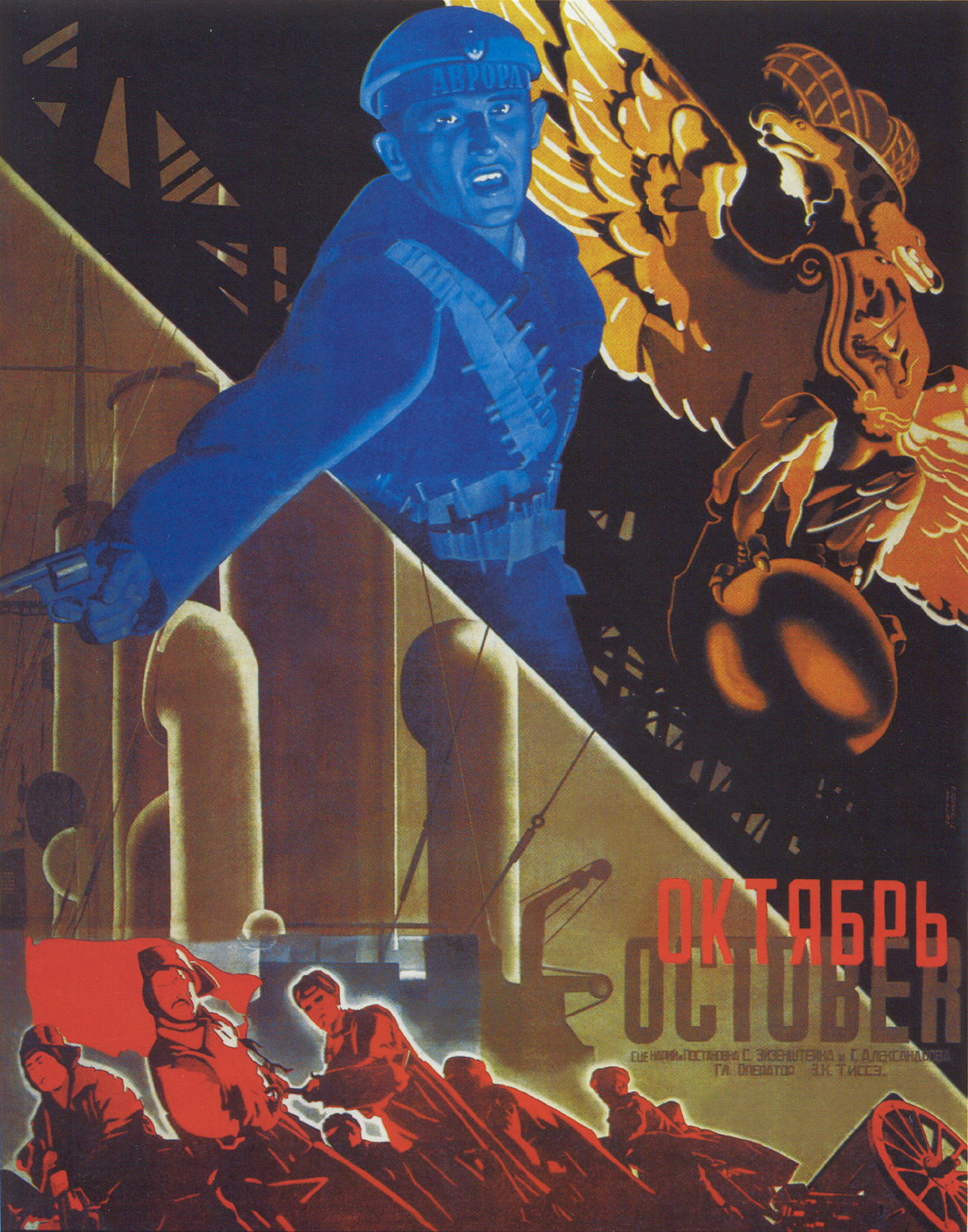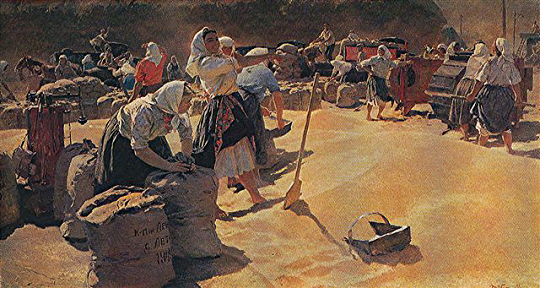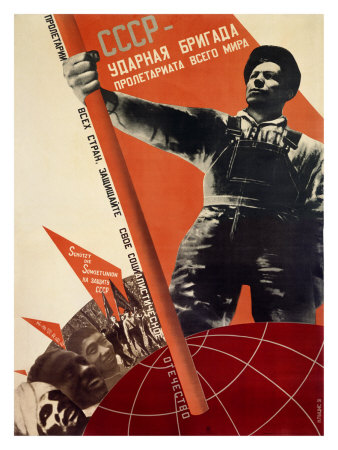Revolutionary Design in Russia
Communism - everything owned by everyone. Money gets shared. Equality.
Capitalism - Everyones to themselves. Keep money etc or yourself.
Full movie ^^
1921 - Octobre - Eisenstein
- Putting foot on crown > crushing royalty
- Up beat music
- picture next to jesus
- Empress' bedroom
- Poor people
- Breaking into palace
- Revolution
- "forward!"
- Let's get Kerensky!
- Stealing
- Hostages
- Military Revolutionary Committee
- Modernist?
- Soviet montage techniques
- Revolutionary and groundbreaking film making at the time
Blue collar workers are taking over, Lenin at the forefront.
Russian Revolution of 1917 overthrows Russian empire. Power struggle between Bolshevik party led by Lenin, and th ANTI-Communist White movement. Bolshevik won the civil war and the Soviet Union was formed which ran until the 90s.
Lenin wanted to overthrow the regime/monarchy.
Everyone was poor, they wanted to change that and have equality.
Red becomes symbolic Bolshevik/communism/soviet union
- 1917-1921 Russian Civil War
- Millions died
- Eisenstein made Oktober on 10th anniversary of revolution as a celebration of October Revolution
- Propaganda
- Revolution
- Everyone stands together
- Working class, everyday men
- Red flag, bolshevism
- Symbolises blood
- Blood of the fallen?
Between 1917 and the mid 1920's there was intense artistic growth and expression. Russians modernised rapidly and extremely quickly.
- Picasso & Matisse
- Lenin etc liked western modernist paintings
- Lenin dies in 1924 and Stalin comes in.
- Stalin bans western style.
- Social realist style comes in.
- Kazmir Malevich
- Abstract
- Suprematism
- Paintings with no meaning came from Russia
Red= bolshevism
revolution symbolism
smashing them gates, in films such as Oktober
White = counter-communist revolutionaries
wedge - strong, cutting edge.
- Rodchenko
- Leading figures
- Artists employed by government for Social Function
- Some kind of design to go outside of libraries, to self-educate
- normal person, a woman, trying to get woman to be equal and to read
- "BOOKS!"
- Very similar to Lissitsky ^^
- Photomontage, experimentation.
- Use of red and black and black and white photographs working with graphic qualities
- Franz Ferdinand references it with their album cover
G.Klutsis "The Electrificiation of the Whole Country" 1920
- NEW Technology
- Embraced photography, new technology
- drawing, photography
- Cut+stick
- Very modernist/experimental
- Triangle+circle again
- Rodchenko - Osip Brik 1923
- 2 negatives stuck together
- Photography used in printing
- Constructivist exhibition
- metaphor for being inside the head
- Tatlin's model of the Monument To The Third International
- 3rd International alliance of commie countries
- Bit like the Eiffel Tower, a symbol of indusrialisation and prosperity. > modernity
- Communist reposte to the Eiffel Tower
- Was supposed to be 3 times as big
- Never came to fruition
- AMBITION
- Modernity
The Constructivists
Photo of Rodchenko by M. Kaufman 1921
- Aim='...achieving the communist expression of communist expression of material structures'.
- Lenin New Economic Policy 1921
- He's presenting himself as kinda modern, futuristic and a labourer. A forward thinking everyday man. What Lenin and the communist Bolshevik regime wanted.
- Like Lening 'constituting' the world
- Rodchenko
- Lenin
Stepanova and Popova
- New design aesthetic
- Started being in any context
- textile and surface design
- Constructivist movement
- Varvara Stepanova
Rodchenko and Stepanova
Popova and Stepanova were rarities in the highly male orientated world of Soviet art
Stepanova become professor of textile design at Vkhutemas. The design school established in Soviet Russia by a decree from Lenin - "to prepare master artists of the highest qualifications for industry, and builders and managers for professional-technical education."
Vkhutemas arguably had just as much expeirmentation and groundbreaking forward thinking as something like Bauhaus. Although because of the history behind it etc Western Historians have wrote very little about it and acknowledged it very little compared to Bauahaus. Maybe this can be an argument or an essay?
Vkhutemas arguably had just as much expeirmentation and groundbreaking forward thinking as something like Bauhaus. Although because of the history behind it etc Western Historians have wrote very little about it and acknowledged it very little compared to Bauahaus. Maybe this can be an argument or an essay?
Dress diesgns for sport. School For social education 1923
- Very unisex, again a nod of the communist ethos of equality.
- Function before form
- Very modernist, not very individualistic
- Geometric
- Constructivist fashion
Wallpaper and printed surface design
- by Melnikov
- 8 years after the socialist revolution to this
- From churches and run down poverty to this
- Architecture
- Similar in a way to Le Corbusier and European architectural movement
- Constructivist aesthetic
- Answer to Britons and maybe Europe that Russia is a new force and a forward thinking nation
Working mens club. In Russia.
"This is the Rusakov Workers’ Club, by Konstantin Melnikov from 1927-28, where Russian working men would go and see the Russian Bernard Mannning.
Of course this show takes art and architecture from a golden period of the Soviet project, before it became dangerous to be clever and that chap with a moustache took control. But it is fascinating to see the art and architecture of a movement that was a complete jump from the politics of the past, and there are so many visionary ideas that permeate our own art, architecture and culture as a whole." Mccann (2011)
Bit different to working mens clubs in Britain! Working class here was clearly important and society and art was based around this class.
VkhUTEMAS
Prospectus cover by Lissitzky
- Art & Design school
- Interdiscplinary like Bauhaus
- Actually predates Bauhaus
- Possibly better and more influential and ahead of its time than Bauhaus?
- At least just as good and important
Women designers,
"It is time to move from designing clothing to designed the structure of the fabric. This will allow the textile industry to jettison its present excessive variety, and help it standardise and improve, at long last, the quality of it's production."
^^industrialisation, mass production and embracing new technologies and quality of product. Function before form mateeee.
Tatlin - Letatilin Flying Machine 1929-31
- Letatlin Sky Bike.
- Mad bastard
- Vkhutemas was shut by Stalin because Stalin was 'orrible.
V. Mukhina 'Industrial worker and collective farm girl' 1935
Artists just starting doing knock offs, and creativity and experimentation really declined.
Gerasimov - 'Sketch for Stalin's speech at 16th party congress' 1931 (take into note WWII kicked off 1939)
- Made to do paintings not for the people as much but for a purpose, Stalins gain
- Propaganda stuff for Stalin
- Went back to the old way of working - painting for churches/institutions/people etc.
- T. Yablonskata 'Corn' 1949
- Very dated looking, especially for 1949 considering the stuff the soviet regime was making in the 20s, which looked much more modernist and forward thinking.
- Inequality is back, old views are back
- women arent equal anymore
- Different view of communism and art isnt really important anymore as a cultural thing but more used for portraits etc for the likes of Stalin.
Klutsis - 'we shall complete the plan of the great works' 1930
Still has quite similar aesthetics to the work of someone like Rodchenko in the early 20s. Cut and paste with graphic qualities.
Decree 394 (1962)
"...about industrial equipment and consumer goods quality improvement by artistic engineering methodology implementation"
- Staline regime worries
- A call to upon "art school"
- Scared to call it art school so they call it that instead@
SUMMARY
- Revolution = new opportunity for art to progress and be forward thinking, sort of a new chapter in Russia and a new chapter for artistic creativity
- Constructivists desire to make art useful
- Aim that art should help 'construct' the new society
- Use of new techniques with abstract aesthetics
- By end of 1920's artistic freedom curtailed
- In 1934 Stalin decreen "socialist realism' only and it changes everything
- Experimentation and creativity wanes
Till about 1932 it was radical and forward thinking, Stalin soon saw to that.








































0 comments:
Post a Comment